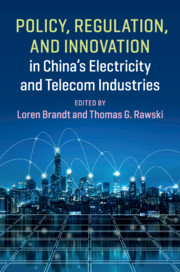Book contents
- Policy, Regulation, and Innovation in China’s Electricity and Telecom Industries
- Policy, Regulation, and Innovation in China’s Electricity and Telecom Industries
- Copyright page
- Contents
- Figures
- Tables
- Contributors
- Acknowledgments
- Abbreviations
- Map of China
- 1 Policy, Regulation, and Innovation in China’s Electricity and Telecom Industries
- 2 China’s Electricity and Communications Regulation in Global Context
- 3 Local Government and Firm Innovation in China’s Clean Energy Sector
- 4 Technology Integration in China’s Electricity System: Central Targets and Local Challenges
- 5 When Global Technology Meets Local Standards
- 6 The Search for High Power in China: State Grid Corporation of China
- 7 Growth, Upgrading, and Limited Catch-Up in China’s Semiconductor Industry
- 8 Growth, Upgrading, and Excess Cost in China’s Electric Power Sector
- 9 China’s Development of Wind and Solar Power
- 10 Capability Upgrading and Catch-Up in Civil Nuclear Power: The Case of China
- Index
- References
3 - Local Government and Firm Innovation in China’s Clean Energy Sector
Published online by Cambridge University Press: 08 June 2019
- Policy, Regulation, and Innovation in China’s Electricity and Telecom Industries
- Policy, Regulation, and Innovation in China’s Electricity and Telecom Industries
- Copyright page
- Contents
- Figures
- Tables
- Contributors
- Acknowledgments
- Abbreviations
- Map of China
- 1 Policy, Regulation, and Innovation in China’s Electricity and Telecom Industries
- 2 China’s Electricity and Communications Regulation in Global Context
- 3 Local Government and Firm Innovation in China’s Clean Energy Sector
- 4 Technology Integration in China’s Electricity System: Central Targets and Local Challenges
- 5 When Global Technology Meets Local Standards
- 6 The Search for High Power in China: State Grid Corporation of China
- 7 Growth, Upgrading, and Limited Catch-Up in China’s Semiconductor Industry
- 8 Growth, Upgrading, and Excess Cost in China’s Electric Power Sector
- 9 China’s Development of Wind and Solar Power
- 10 Capability Upgrading and Catch-Up in Civil Nuclear Power: The Case of China
- Index
- References
Summary
Local governments play an important role in China’s economy, and many studies credit local governments with a beneficial role in promoting growth over the past decades, especially in manufacturing. The extensive literature on Chinese innovation is relatively silent, however, on the impact of Chinese local governments on industrial upgrading. This chapter’s empirical focus is local government influence on the ecosystem for innovation in clean energy manufacturing industries, specifically solar cells (PVs) and electric vehicles (EVs). While innovation in the clean energy sector has been a key theme of the government’s response to environmental degradation and climate change, clean energy manufacturing is perhaps foremost an industrial policy. Moreover, subnational governments remain core actors through their dual role as promoters of local development and conduits of central policy initiatives. Sometimes central and local goals align favorably for firm innovation, and sometimes they conflict. In the sectors studied, local government efforts to promote upgrading has occurred in niche areas, notably in the low-speed electric vehicle sector. Yet local government efforts often have been wasteful –promoting excessive market entry and questionable incentive schemes –falling short of goals for upgrading.
Keywords
- Type
- Chapter
- Information
- Publisher: Cambridge University PressPrint publication year: 2019
References
- 3
- Cited by

